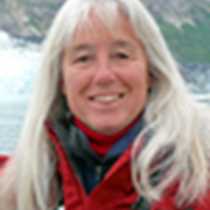Los Islotes/Bahia Bonanza, Isla Espiritu Santo
At first light the National Geographic Sea Lion was approaching the volcanic formations known as Los Islotes, just to the north of Islas Partida and Espiritu Santo. As we got closer to our anchorage, we could hear the cacophony of the California sea lions that make this isolated place their home: teenage bulls, adult females and one- and two-year-old pups. Birds were also coming and going, or looking for food around the rocks.
After breakfast we boarded the Zodiacs to tour along the islets for a closer look and to learn about the life cycles of the birds and the sea lions. Small numbers of blue-footed and brown boobies nest here. A major nesting place for these birds is found on Isla San Pedro Mártir, further north in the Sea of Cortez. Magnificent frigatebirds, yellow-footed gulls, turkey vultures and Brandt’s cormorants come here to roost nightly. The yellow-footed gull is a specialty bird for the Sea of Cortez. Great blue herons and peregrine falcons are known to nest occasionally.
It was disturbing to see several sea lions with scars around their necks from entanglement with fishing gear, but heartening to learn that Lindblad Expeditions supports a disentanglement program for the sea lions at Los Islotes.
When the Zodiac tours were completed, some of us dipped beneath the water’s surface to interact with the playful sea lions and view the fish and invertebrates in the colorful underwater world.
Through the spotting scope on the deck of the ship, guests could view a peregrine falcon sitting on the light tower.
The National Geographic Sea Lion pulled anchor and cruised down the east side of Islas Partida and Espiritu Santo and re-anchored in a bay with a long, idyllic stretch of beach known as Bahia Bonanza on Isla Espiritu Santo. The island is known for its endemic species of antelope ground squirrel and black jackrabbit, which a few people were lucky enough to spot on walks in the desert. Other people spent the final afternoon contemplating the events of the expedition cruise by taking a leisurely stroll down the beach, a peaceful cruise by kayak along the shoreline, or snorkeling along a rocky reef.
At first light the National Geographic Sea Lion was approaching the volcanic formations known as Los Islotes, just to the north of Islas Partida and Espiritu Santo. As we got closer to our anchorage, we could hear the cacophony of the California sea lions that make this isolated place their home: teenage bulls, adult females and one- and two-year-old pups. Birds were also coming and going, or looking for food around the rocks.
After breakfast we boarded the Zodiacs to tour along the islets for a closer look and to learn about the life cycles of the birds and the sea lions. Small numbers of blue-footed and brown boobies nest here. A major nesting place for these birds is found on Isla San Pedro Mártir, further north in the Sea of Cortez. Magnificent frigatebirds, yellow-footed gulls, turkey vultures and Brandt’s cormorants come here to roost nightly. The yellow-footed gull is a specialty bird for the Sea of Cortez. Great blue herons and peregrine falcons are known to nest occasionally.
It was disturbing to see several sea lions with scars around their necks from entanglement with fishing gear, but heartening to learn that Lindblad Expeditions supports a disentanglement program for the sea lions at Los Islotes.
When the Zodiac tours were completed, some of us dipped beneath the water’s surface to interact with the playful sea lions and view the fish and invertebrates in the colorful underwater world.
Through the spotting scope on the deck of the ship, guests could view a peregrine falcon sitting on the light tower.
The National Geographic Sea Lion pulled anchor and cruised down the east side of Islas Partida and Espiritu Santo and re-anchored in a bay with a long, idyllic stretch of beach known as Bahia Bonanza on Isla Espiritu Santo. The island is known for its endemic species of antelope ground squirrel and black jackrabbit, which a few people were lucky enough to spot on walks in the desert. Other people spent the final afternoon contemplating the events of the expedition cruise by taking a leisurely stroll down the beach, a peaceful cruise by kayak along the shoreline, or snorkeling along a rocky reef.



